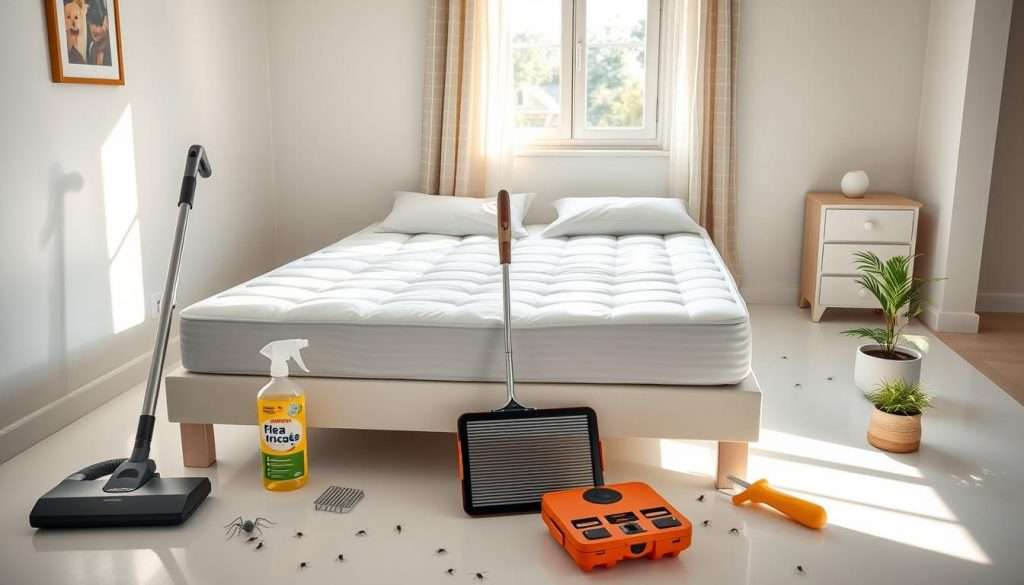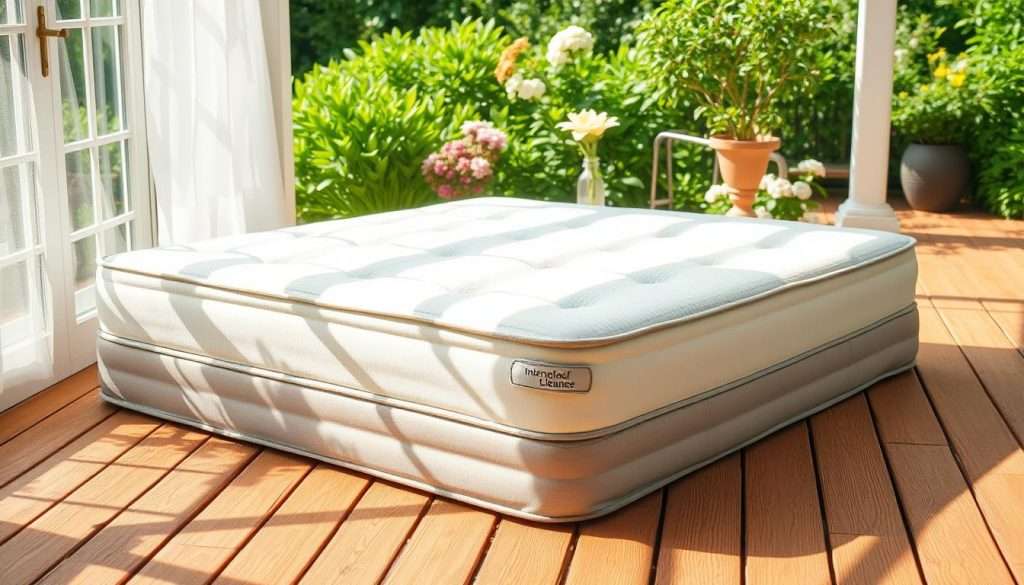Dealing with fleas on your mattress can be really tough. Fleas in mattresses make sleeping hard and can even hurt your health. So, it’s key to clean your mattress well to sleep better.
To get rid of fleas, check out flea removal guides online. Vacuuming your mattress and bedroom often helps. Also, using flea-proof covers and keeping your pets clean are good ways to stop fleas.

Key Takeaways
- Understanding the severity of the flea infestation is crucial for effective treatment.
- Regular vacuuming and mattress cleaning can help prevent flea infestations.
- Choosing between natural remedies and chemical treatments depends on personal preferences and the severity of the infestation.
- High temperatures can effectively kill fleas, larvae, and eggs, making washing bedding in hot water an effective method.
- Considering mattresses designed with materials that resist allergens and pests can help prevent future flea infestations.
- Proper cleaning methods can effectively eliminate fleas from a mattress, making it unnecessary to throw it away.
Initial Cleaning Process
Removing fleas from your mattress starts with vacuuming. This step is key to get rid of fleas and their eggs. Focus on seams and crevices, where fleas hide. Use a vacuum with a gentle setting to avoid pushing fleas deeper.
Steam cleaning is also effective. The steam’s high temperature kills fleas and eggs. But, use a steam cleaner with a gentle setting to protect your mattress.
Vacuum Thoroughly
Vacuuming well is important to remove fleas and eggs. Pay extra attention to seams and crevices. Also, throw away the vacuum bag or empty the canister after each use to stop fleas from coming back.
Steam Clean the Mattress
Steam cleaning is a bit more work but it’s good for sanitizing your mattress. Use a gentle steam cleaner setting and cover the whole mattress slowly. This helps get rid of fleas and eggs in the mattress.
By vacuuming and steam cleaning, you can get rid of fleas and eggs from your mattress. Always keep up the fight against fleas. They can quickly multiply and infest your home again if not treated.
Treatment Methods
There are many ways to treat your mattress for fleas. You can try natural or chemical treatments. Natural methods, like diatomaceous earth, are safe and work well. This powder dries out fleas, killing them.
Chemical treatments, like sprays, work fast but need care. Think about what’s best for you and your home. For example, natural flea treatments are safer, but chemical flea treatments might be needed for big problems.
Natural Solutions
Natural options, like diatomaceous earth, salt, and baking soda, dry out fleas. They’re good for the planet and pets. Vacuuming often can also stop fleas from coming back.
Chemical Treatments
Chemical sprays can solve flea problems fast but need caution. Always follow the directions and protect yourself. For big flea issues, talk to a pest control expert.
Some common chemical treatments are:
- Insecticide sprays
- Flea bombs
- Spot-on treatments
Always focus on getting rid of fleas and stopping them from coming back. This includes washing your bedding and treating your yard.

Post-Treatment Steps
After treating your mattress for fleas, it’s key to take steps to stop fleas from coming back. Drying and ventilation help stop moisture buildup, which fleas like. Make sure your mattress has good airflow to stay dry and fresh.
To keep your mattress flea-free, follow these steps:
- Regularly check your mattress for flea dirt or bites
- Use a mattress cover to keep fleas out
- Vacuum your mattress often, after flea treatments
Good flea prevention needs these steps and regular treatments. By doing these, you can stop fleas from coming back. Always check your mattress for fleas and act fast if you see any.

By following these easy steps, you can have a comfy and flea-free bed. We suggest you actively keep your mattress clean to avoid future infestations.
Bedding Treatment
It’s very important to treat your bedding to stop fleas from coming back. Wash your sheets, pillowcases, and mattress covers in hot water (at least 120°F). This helps kill fleas and their eggs.
Also, dry your bedding on the highest heat setting. This makes sure all fleas are gone. By doing these simple steps, you can keep your home flea-free. This protects your family and pets from fleas’ discomfort and health risks.
Keep in mind, fleas can be hard to get rid of. So, always watch for signs of fleas coming back. Regular vacuuming, pet grooming, and using flea control products help a lot. If fleas keep coming back, get help from a professional pest control service. They can make sure all fleas are gone for good.
